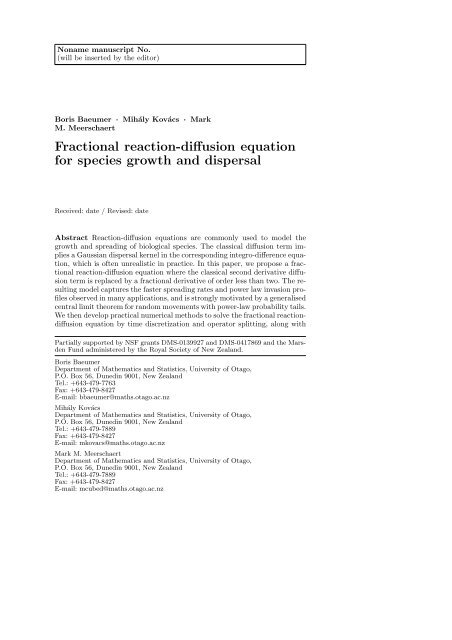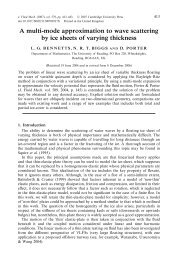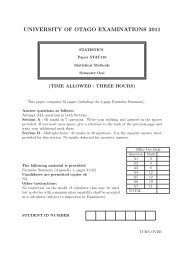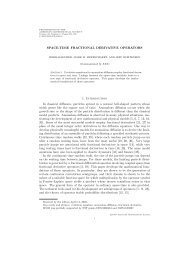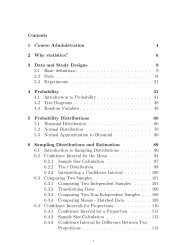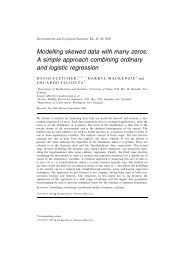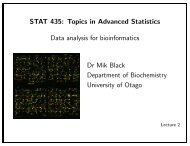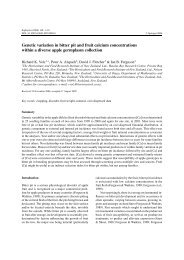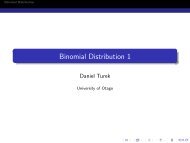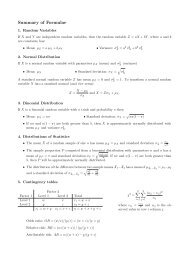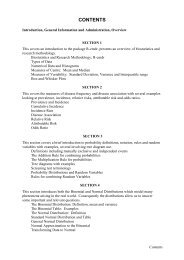Fractional reaction-diffusion equation for species ... - ResearchGate
Fractional reaction-diffusion equation for species ... - ResearchGate
Fractional reaction-diffusion equation for species ... - ResearchGate
You also want an ePaper? Increase the reach of your titles
YUMPU automatically turns print PDFs into web optimized ePapers that Google loves.
Noname manuscript No.<br />
(will be inserted by the editor)<br />
Boris Baeumer · Mihály Kovács · Mark<br />
M. Meerschaert<br />
<strong>Fractional</strong> <strong>reaction</strong>-<strong>diffusion</strong> <strong>equation</strong><br />
<strong>for</strong> <strong>species</strong> growth and dispersal<br />
Received: date / Revised: date<br />
Abstract Reaction-<strong>diffusion</strong> <strong>equation</strong>s are commonly used to model the<br />
growth and spreading of biological <strong>species</strong>. The classical <strong>diffusion</strong> term implies<br />
a Gaussian dispersal kernel in the corresponding integro-difference <strong>equation</strong>,<br />
which is often unrealistic in practice. In this paper, we propose a fractional<br />
<strong>reaction</strong>-<strong>diffusion</strong> <strong>equation</strong> where the classical second derivative <strong>diffusion</strong><br />
term is replaced by a fractional derivative of order less than two. The resulting<br />
model captures the faster spreading rates and power law invasion profiles<br />
observed in many applications, and is strongly motivated by a generalised<br />
central limit theorem <strong>for</strong> random movements with power-law probability tails.<br />
We then develop practical numerical methods to solve the fractional <strong>reaction</strong><strong>diffusion</strong><br />
<strong>equation</strong> by time discretization and operator splitting, along with<br />
Partially supported by NSF grants DMS-0139927 and DMS-0417869 and the Marsden<br />
Fund administered by the Royal Society of New Zealand.<br />
Boris Baeumer<br />
Department of Mathematics and Statistics, University of Otago,<br />
P.O. Box 56, Dunedin 9001, New Zealand<br />
Tel.: +643-479-7763<br />
Fax: +643-479-8427<br />
E-mail: bbaeumer@maths.otago.ac.nz<br />
Mihály Kovács<br />
Department of Mathematics and Statistics, University of Otago,<br />
P.O. Box 56, Dunedin 9001, New Zealand<br />
Tel.: +643-479-7889<br />
Fax: +643-479-8427<br />
E-mail: mkovacs@maths.otago.ac.nz<br />
Mark M. Meerschaert<br />
Department of Mathematics and Statistics, University of Otago,<br />
P.O. Box 56, Dunedin 9001, New Zealand<br />
Tel.: +643-479-7889<br />
Fax: +643-479-8427<br />
E-mail: mcubed@maths.otago.ac.nz
2 Baeumer, Kovács, Meerschaert<br />
some existing methods from the literature on anomalous super-<strong>diffusion</strong>. In<br />
the process, we establish the mathematical relationship between the discrete<br />
time integro-difference and continuous time <strong>reaction</strong>-<strong>diffusion</strong> analogues of<br />
the model, along with error bounds. Our general approach also applies to<br />
other alternative non-Gaussian dispersal kernels, and it identifies the analogous<br />
continuous time evolution <strong>equation</strong>s <strong>for</strong> those models.<br />
Keywords <strong>reaction</strong>-<strong>diffusion</strong> <strong>equation</strong> · growth and dispersal · fractional<br />
derivative · anomalous <strong>diffusion</strong> · operator splitting<br />
Mathematics Subject Classification (2000) 35K57 · 26A33 · 47D03<br />
1 Introduction<br />
Classical <strong>reaction</strong>-<strong>diffusion</strong> <strong>equation</strong>s are useful to model the spread of invasive<br />
<strong>species</strong> [40,41]. In this model, the population density u(x, t) at location<br />
x and time t is the solution of the partial differential <strong>equation</strong><br />
∂u<br />
∂t = f(u) + D ∂2 u<br />
∂x 2 . (1)<br />
The first term on the right is the <strong>reaction</strong> term that models population<br />
growth; a typical choice is Fisher’s <strong>equation</strong> f(u) = ru(1 − u/K) where r is<br />
the intrinsic growth rate and K is the carrying capacity. The second term<br />
is the <strong>diffusion</strong> term; it models spreading/dispersion. Solutions to (1) spread<br />
at a rate proportional to t with exponential leading edges. The main failure<br />
of this model in real applications is the unrealistically slow spreading, since<br />
typical invasive <strong>species</strong> have population densities that spread faster than t,<br />
with power law leading edges [13,16,17,26,28,43]. The power law exhibits as<br />
a straight line on a log-log plot of dispersive distance, a phenomenon often<br />
seen in field data [58–60]. In this paper, we propose an alternative fractional<br />
<strong>reaction</strong>-<strong>diffusion</strong> <strong>equation</strong><br />
∂u<br />
∂t = f(u) + D ∂α u<br />
∂x α (2)<br />
with 0 < α ≤ 2, which reduces to the classical <strong>equation</strong> if α = 2. Solutions to<br />
(2) spread faster than t with power law leading edges [19] and hence provide<br />
a more realistic model <strong>for</strong> invasive <strong>species</strong>.<br />
<strong>Fractional</strong> derivatives are almost as old as their more familiar integerorder<br />
counterparts [37,48]. <strong>Fractional</strong> derivatives have recently been applied<br />
to many problems in physics [5,10,11,27,32–35,47,61], finance [22,45,46,51–<br />
53], and hydrology [4,6–8,55,56]. If a function u(x) has Fourier trans<strong>for</strong>m<br />
û(λ) = ∫ e −iλx u(x)dx then the fractional derivative d α u(x)/dx α has Fourier<br />
trans<strong>for</strong>m (iλ) α û(λ), extending the familiar <strong>for</strong>mula <strong>for</strong> integer α. <strong>Fractional</strong><br />
derivatives are used to model anomalous <strong>diffusion</strong> or dispersion, where a<br />
particle plume spreads at a different rate than the classical <strong>diffusion</strong> model<br />
predicts [15,34]. Just as the fundamental solution to the classical <strong>diffusion</strong><br />
<strong>equation</strong> is provided by the normal or Gaussian probability density functions<br />
of a Brownian motion, the α-stable probability density functions [21,49] of
<strong>Fractional</strong> <strong>reaction</strong>-<strong>diffusion</strong> <strong>equation</strong> 3<br />
a Lévy motion [9,50] solve the fractional <strong>diffusion</strong> <strong>equation</strong> [32,57]. This is<br />
because fractional derivatives arise from sums of random movements with<br />
power law probability tails [56,31], <strong>for</strong> which the usual central limit theorem<br />
is replaced by its heavy tail analogue [21,36].<br />
An alternative discrete time model <strong>for</strong> population growth and dispersal<br />
uses an integro-difference <strong>equation</strong><br />
u(x, t + τ) =<br />
∫ ∞<br />
−∞<br />
k τ (x, y)g τ (u(y, t))dy (3)<br />
where the dispersal kernel k τ (x, y) is the probability density of the location<br />
x to which an individual disperses at time t + τ, given that the individual<br />
is located at spatial coordinate y at time t [30,41]. Equation (3) can be<br />
understood as a two-step process: First we apply the iteration <strong>equation</strong> u →<br />
g τ (u) to grow the population over one time step, and then we integrate<br />
against the kernel k τ (x, y) to disperse the population over the same time step.<br />
The classical <strong>reaction</strong>-<strong>diffusion</strong> model (1) can be approximated (in a way we<br />
will make precise later in this paper) with the discrete time model (3) where<br />
g(u 0 ) is the solution to the ordinary differential <strong>equation</strong> ˙u = f(u); u(0) = u 0<br />
at time t = τ and<br />
k τ (x, y) = √ 1<br />
4πDτ<br />
e − (x−y)2<br />
4Dτ (4)<br />
is a Gaussian dispersal kernel, the fundamental solution to the classical <strong>diffusion</strong><br />
<strong>equation</strong><br />
∂u<br />
∂t = D ∂2 u<br />
; u(x, t = 0) = δ(x − y)<br />
∂x2 at time t = τ. In the same manner, we will show in this paper that solutions to<br />
the fractional <strong>reaction</strong>-<strong>diffusion</strong> <strong>equation</strong> (2) can be usefully approximated by<br />
the same iteration <strong>equation</strong> (3) with the only change being that the dispersal<br />
kernel k τ (x, y) is the fundamental solution to the fractional <strong>diffusion</strong> <strong>equation</strong><br />
∂u<br />
∂t = D ∂α u<br />
; u(x, t = 0) = δ(x − y)<br />
∂xα at time t = τ. This dispersal kernel can be explicitly computed [14,42,49].<br />
Ecologists have also experimented with other alternative kernels incorporating<br />
skewness and heavier probability tails, such as the Gamma, Laplace,<br />
Weibull, and Student-t distribution [13,16,17,30,39]. This paper will also<br />
show how those models relate to a variant of the fractional <strong>reaction</strong>-<strong>diffusion</strong><br />
<strong>equation</strong> (2), and the exact manner in which the discrete time evolution<br />
<strong>equation</strong> (3) can be used to approximate the solution of the continuous time<br />
<strong>reaction</strong>-<strong>diffusion</strong> <strong>equation</strong> in this case. Our methods also provide explicit<br />
error bounds on the approximation, which are useful in numerical simulations.<br />
These methods also extend to the case where the <strong>reaction</strong> term f(u, x)<br />
explicitly depends on the space variable x. This includes, <strong>for</strong> example, the<br />
Fisher <strong>equation</strong> with space-variable intrinsic growth rate r(x) and carrying<br />
capacity K(x). Finally we note that, since <strong>reaction</strong>-<strong>diffusion</strong> <strong>equation</strong>s are<br />
also important in other areas where anomalous <strong>diffusion</strong> is widely observed,<br />
including cell biology, chemistry, physics, geophysics, and finance, it seems<br />
likely that the results reported here will also be useful in a broader context.
4 Baeumer, Kovács, Meerschaert<br />
2 Problem outline<br />
The classical <strong>reaction</strong>-<strong>diffusion</strong> <strong>equation</strong> (1) and its fractional analogue (2)<br />
are both special cases of a general <strong>for</strong>m<br />
∂u<br />
∂t (x, t) = (Au)(x, t) + f(u(x, t)), u(x, 0) = u 0(x) (5)<br />
where A is a pseudo-differential operator [25] that appears as the generator<br />
of some continuous convolution semigroup [1,44]. Our goal in this section is<br />
to explore the connection between this continuous time evolution <strong>equation</strong><br />
and its discrete time analogue, the integro-difference <strong>equation</strong><br />
u n+1 (x) =<br />
∫ ∞<br />
−∞<br />
k τ (x, y)g τ (u n (y)) dy (6)<br />
where u n (x) = u(x, nτ) with some τ > 0 fixed. Our general approach is based<br />
operator theory <strong>for</strong> abstract differential <strong>equation</strong>s [1,20,44] and infinitely<br />
divisible probability distributions [21,36].<br />
Example 1 To demonstrate the basic idea let us consider the classical <strong>reaction</strong><strong>diffusion</strong><br />
<strong>equation</strong> (1) with a growth term f(u) = ru <strong>for</strong> some real r ≥ 0. It<br />
is well know that if r = 0 then the solution is given by<br />
u(x, t) =<br />
∫ ∞<br />
−∞<br />
1<br />
√ e − (x−y)2<br />
4Dt u 0 (y) dy := [T (t)u 0 ](x)<br />
4πDt<br />
where the dispersal operator T (t) maps the initial condition at time t = 0,<br />
the function u 0 (x), to the solution of the <strong>diffusion</strong> <strong>equation</strong> at time t > 0.<br />
Likewise, if D = 0 then the solution is given by<br />
u(x, t) = e rt u 0 (x) := [S(t)u 0 ](x).<br />
where the growth operator S(t) maps the initial condition to the solution of<br />
the growth <strong>equation</strong> at time t > 0. Clearly, [S(t+s)u 0 ](x) = [S(t)S(s)u 0 ](x) =<br />
[S(s)S(t)u 0 ](x) and [T (t + s)u 0 ](x) = [T (t)T (s)u 0 ](x) = [T (s)T (t)u 0 ](x) <strong>for</strong><br />
all t, s ≥ 0 (the semigroup property). Using the product rule its is easy to see<br />
that the solution to (1) is of the <strong>for</strong>m<br />
u(x, t) =<br />
∫ ∞<br />
−∞<br />
√ 1<br />
4πDt<br />
e − (x−y)2<br />
4Dt e rt u 0 (y) dy = [T (t)S(t)u 0 ](x) (7)<br />
= [S(t)T (t)u 0 ](x) = e rt ∫ ∞<br />
−∞<br />
√ 1<br />
4πDt<br />
e − (x−y)2<br />
4Dt u 0 (y) dy, (8)<br />
that is; the solution of the complex problem (1) can be written using the<br />
solution of the simpler sub-problems. Now if we fix τ > 0, then by (7) and<br />
(8) we have<br />
u n+1 (x) = u(x, (n + 1)τ) = [T ((n + 1)τ)S((n + 1)τ)u 0 ](x)<br />
= [(T (τ)) n+1 (S(τ)) n+1 u 0 ](x) = [T (τ)S(τ)(T (τ)) n (S(τ)) n u 0 ](x)<br />
= [T (τ)S(τ)T (nτ)S(nτ)u 0 ](x) = [T (τ)S(τ)u n ](x)<br />
=<br />
∫ ∞<br />
−∞<br />
√ 1<br />
4πDτ<br />
e − (x−y)2<br />
4Dτ e rτ u n (y) dy :=<br />
∫ ∞<br />
−∞<br />
k τ (x, y)g τ (u n (y)) dy.
<strong>Fractional</strong> <strong>reaction</strong>-<strong>diffusion</strong> <strong>equation</strong> 5<br />
This means that the exact solution at time t = nτ, <strong>for</strong> any positive integer<br />
n = 1, 2, . . . satisfies an iteration of the <strong>for</strong>m (6) with k τ given by (4) and<br />
g τ (u n (y)) = e rτ u n (y). Iterations of the <strong>for</strong>m u n+1 = S(τ)T (τ)(u n ) are called<br />
sequential splitting.<br />
We now try to follow the same basic idea in the case when both the differential<br />
operator and the growth term are more complicated. Assume that<br />
the continuous model is well posed in the sense that given u 0 we obtain a<br />
unique solution on R × [0, T ]. In this case, at least <strong>for</strong>mally, the solution can<br />
be written as u(x, t) = [W (t)u 0 ](x) and we call W (t) the solution operator<br />
of (5). In Example 1 the solution operator is given by (7) and since T (t)<br />
and S(t) commute W (t) = T (t)S(t). If we would be able to construct W (t)<br />
as in Example 1, then the solution of (5) would satisfy the natural iteration<br />
u n+1 (x) = [W (τ)u n ](x). Un<strong>for</strong>tunately if the function f is not just a multiplication<br />
by a constant, then it is usually impossible to obtain a closed <strong>for</strong>m<br />
of W (t). There<strong>for</strong>e, we might want to follow the idea of sequential splitting<br />
here, too, that is; instead of looking at (5) we look at two separate differential<br />
<strong>equation</strong>s which are easier to solve and construct an iteration based on<br />
their solutions. Of course we then have to investigate what this has to do<br />
with W (t), the solution operator of (5). Let us denote by T (t) the solution<br />
operator to the pseudo-differential <strong>equation</strong><br />
and by S(t) the solution operator to<br />
∂u<br />
(x, t) = (Au)(x, t) (9)<br />
∂t<br />
∂u<br />
(x, t) = f(u(x, t)). (10)<br />
∂t<br />
The idea behind sequential splitting is that <strong>for</strong> τ small, we solve first (10)<br />
on [0, τ] and then using the obtained solution at time t = τ as initial data<br />
<strong>for</strong> (9) we solve that on [0, τ]. Then hope that this will be close to the result<br />
if we would do both at the same time. Mathematically, instead of computing<br />
[W (τ)u 0 ](x) we compute [T (τ)S(τ)u 0 ](x). Now if S(t) and T (t) commute,<br />
then this is the same thing. If not, then it is usually different. Assume<br />
that we are interested in the solution of (5) at time t = nτ. Then, by the<br />
above described idea, we set up an iteration u n+1 (x) = [T (τ)S(τ)u n ](x) with<br />
starting value u 0 , or equivalently, u n+1 (x) = [(T (τ)S(τ)) n u 0 ] (x). Usually,<br />
u n (x) ≠ u(x, nτ) (except <strong>for</strong> the commuting case), but is it true that u n (x)<br />
is close to u(x, nτ) in some sense For example, if we fix t and choose finer<br />
and finer time steps τ = t n , then does u n(x) converge to u(x, t) in some<br />
sense as n → ∞, in other words, does [ T ( t n )S( t n )] n<br />
u0 converge to W (t)u 0<br />
as n → ∞<br />
Example 2 Let us consider the fractional <strong>reaction</strong>-<strong>diffusion</strong> <strong>equation</strong> with<br />
Fisher’s growth term<br />
( )<br />
∂u<br />
∂t (x, t) = ru(x, t) u(x, t)<br />
1 − + D ∂α u<br />
K ∂x α (x, t); u(x, 0) = u 0(x) (11)
6 Baeumer, Kovács, Meerschaert<br />
where 1 < α ≤ 2. To apply the sequential operator splitting procedure, we<br />
first consider the fractional <strong>diffusion</strong> <strong>equation</strong><br />
∂u<br />
∂t (x, t) = D ∂α u<br />
∂x α (x, t); u(x, 0) = u 0(x) (12)<br />
which ∫ can be solved by Fourier trans<strong>for</strong>m methods [15,32]: Write û(λ, t) =<br />
e −iλx u(x, t)dx and recall that ∂ α u/∂x α has Fourier trans<strong>for</strong>m (iλ) α û. Taking<br />
Fourier trans<strong>for</strong>ms on both sides of (12) yields the ordinary differential<br />
<strong>equation</strong><br />
d<br />
dtû(λ, t) = D(iλ)α û(λ, t); û(λ, 0) = û 0 (λ)<br />
whose solution is evidently of the <strong>for</strong>m<br />
û(λ, t) = û 0 (λ) exp(tD(iλ) α )<br />
and now we use the fact from probability theory that exp(C(iλ) α ) is known<br />
to be the Fourier trans<strong>for</strong>m of an α-stable probability density, which appears<br />
in the generalised central limit theorem [21,36,49]. Then we may write<br />
u(x, t) = [T (t)u 0 ](x) =<br />
∫ ∞<br />
−∞<br />
k t (x − y)u 0 (y) dy (13)<br />
where k t (x) is an α-stable probability density. Next consider the growth<br />
<strong>equation</strong><br />
( )<br />
∂u<br />
∂t (x, t) = ru(x, t) u(x, t)<br />
1 − ; u(x, 0) = u 0 (x)<br />
K<br />
with solution<br />
u(x, t) = [S(t)u 0 ](x)<br />
= [ ˜S(t)](u 0 (x)) = K<br />
(<br />
)<br />
K − u 0 (x)<br />
1 −<br />
K + u 0 (x)(exp(rt) − 1)<br />
(14)<br />
where we emphasise that the nonlinear operator S(t) maps the function u 0 to<br />
another real-valued function of x, and ˜S(t) is a function that maps the real<br />
number u 0 (x) to another real number. According to the discussion above,<br />
define an iteration based on the sequential splitting by<br />
u n+1 (x) = [T (τ)S(τ)u n ](x)<br />
=<br />
∫ ∞<br />
−∞<br />
k τ (x − y)K<br />
(<br />
)<br />
K − u n (y)<br />
1 −<br />
dy.<br />
K + u n (y)(exp(rτ) − 1)<br />
(15)<br />
This is a discrete time evolution <strong>equation</strong> of the <strong>for</strong>m (6), an approximate<br />
solution u(x, nτ) of the fractional <strong>reaction</strong>-<strong>diffusion</strong> <strong>equation</strong> (11). Our goal<br />
is to show that this approximate solution converges to the actual solution as<br />
the time step τ tends to zero.
<strong>Fractional</strong> <strong>reaction</strong>-<strong>diffusion</strong> <strong>equation</strong> 7<br />
Remark 1 The splitting method (15) has a useful biological interpretation.<br />
Given a typical time scale τ, the <strong>for</strong>mula (15) expresses that the population<br />
first increases via an application of the growth operator S(τ), and then<br />
spreads out via an application of the dispersal operator T (τ). Similarly, if we<br />
model first dispersion and then growth, we obtain the alternative sequential<br />
splitting<br />
u n+1 (x) := [S(τ)T (τ)u n ](x)<br />
⎛<br />
(∫ ∞<br />
K −<br />
= K ⎜<br />
⎝ 1 −<br />
−∞<br />
)<br />
k τ (x − y)u n (y) dy<br />
)<br />
(∫ ∞<br />
K + k τ (x − y)u n (y) dy<br />
−∞<br />
⎞<br />
⎟<br />
⎠ . (16)<br />
(exp(rτ) − 1)<br />
In this paper, we will show that both approaches lead to the same continuous<br />
time limit.<br />
In the next section, we will prove that solutions to the discrete time<br />
integro-difference <strong>equation</strong> with an α-stable dispersal kernel converge to solutions<br />
of the fractional <strong>reaction</strong>-<strong>diffusion</strong> <strong>equation</strong> as the time step tends to<br />
zero. We will do this by proving a more general result, that also applies to<br />
other useful dispersal kernels. If the growth term f(u) = ru(1 − u/K) as in<br />
Example 2, we will also show that these splitting procedures provide lower<br />
and upper bounds <strong>for</strong> solutions to the continuous time model. These bounds<br />
will be useful in the numerical methods discussed in Section 4.<br />
3 Mathematical details<br />
Let X be a Banach space of functions u : R → R with associated norm<br />
‖u‖, and consider the abstract <strong>reaction</strong>-<strong>diffusion</strong> <strong>equation</strong> (5) which we will<br />
rewrite here in operator theory notation as<br />
˙u(t) = Au(t) + f(u(t)), t > 0, u(0) = u 0 (17)<br />
to emphasise our point of view that u : [0, ∞) → X and f : X → X. Here<br />
A is the generator of a strongly continuous semigroup {T (t)} t≥0 on X, a one<br />
parameter family of linear operators T (t) : X → X such that: T (0) = I the<br />
identity operator (Iu = u); each T (t) is bounded, meaning that there exists<br />
a real number M > 0 depending on t > 0 such that ‖T (t)u‖ ≤ M‖u‖ <strong>for</strong> all<br />
u ∈ X; T (t+s) = T (t)T (s) <strong>for</strong> t, s ≥ 0; t ↦→ T (t)u is continuous in the Banach<br />
space norm <strong>for</strong> all u ∈ X; and the generator Au = lim h→0+ h −1 (T (h)u − u)<br />
exists <strong>for</strong> at least some nonzero u ∈ X. We call the set D(A) ⊂ X <strong>for</strong><br />
which this limit exists the domain of the linear operator A, and we say that<br />
the semigroup T (t) is generated by A. We say that u : [0, δ) → X is a<br />
local classical/strong solution of (17) if u is continuous on [0, δ), continuously<br />
differentiable on (0, δ), u(t) ∈ D(A) <strong>for</strong> t ∈ (0, δ) and u satisfies (17) on<br />
(0, δ). If δ can be chosen arbitrarily large then u is a global classical/strong
8 Baeumer, Kovács, Meerschaert<br />
solution of (17). A function u : [0, δ) → X is a local mild solution of (17) if u<br />
is continuous and satisfies the corresponding integral <strong>equation</strong><br />
u(t) = T (t)u 0 +<br />
∫ t<br />
0<br />
T (t − s)f(u(s)) ds, 0 ≤ t < δ. (18)<br />
We note that the integral in (18) is a Bochner integral [1,24,44], an extension<br />
of the Lebesgue integral to the Banach space setting which coincides with a<br />
Riemann integral if the integrand is continuous in the Banach space norm.<br />
If δ can be chosen arbitrarily large then u is a global mild solution of (17).<br />
If f : X → X is Lipschitz continuous, that is; ||f(u) − f(v)|| ≤ M||u − v||<br />
<strong>for</strong> all u, v ∈ X, then <strong>for</strong> all u 0 ∈ X there is a unique global mild solution<br />
u(t) := W (t)u 0 of (17) with ||W (t)u 0 − W (t)v 0 || ≤ M T ||u 0 − v 0 ||, t ∈ [0, T ]<br />
(see, <strong>for</strong> example, [44, Section 6.1]). Denote the unique mild solution of (17)<br />
in the special case A ≡ 0 by u(t) := S(t)u 0 . In this case T (t)u = u <strong>for</strong> all<br />
t ≥ 0, and hence it follows from (18) that<br />
u(t) = u 0 +<br />
∫ t<br />
0<br />
f(u(s)) ds (19)<br />
<strong>for</strong> all t > 0. Then u is also a strong solution, since if u and f are continuous,<br />
then t ↦→ f(u(t)) is also continuous and t ↦→ ∫ t<br />
f(u(s)) ds is differentiable,<br />
∫<br />
0<br />
and d t<br />
dt<br />
f(u(s)) ds = f(u(t)) (see, e.g., [24, page 67]). There<strong>for</strong>e t → u(t) is<br />
0<br />
differentiable in view of (19), and ˙u(t) = f(u(t)). It also follows from (19) that<br />
the collection of nonlinear operators {S(t)} t≥0 <strong>for</strong>ms a semigroup, sometimes<br />
called the flow of the abstract differential <strong>equation</strong> ˙u = f(u). We say that the<br />
collection S(·) is generated by f. It is well known that the solution operator<br />
W (t)u 0 to the abstract <strong>reaction</strong>-<strong>diffusion</strong> <strong>equation</strong> (17) can be computed by<br />
the Trotter Product Formula<br />
[<br />
W (t)u 0 = lim T (<br />
t<br />
n→∞ n )S( t n )] n [<br />
u0 = lim S(<br />
t<br />
n→∞ n )T ( t n )] n<br />
u0 , u 0 ∈ X, (20)<br />
see, <strong>for</strong> example, [12,18,38]. This result means that the mild solution to the<br />
abstract <strong>reaction</strong>-<strong>diffusion</strong> <strong>equation</strong> (17) can be computed as an approximation<br />
using the mild solutions of the two sub-problems, the abstract <strong>reaction</strong><br />
<strong>equation</strong> ˙u = f(u) and the abstract <strong>diffusion</strong> <strong>equation</strong> ˙u = Au.<br />
The following proposition is a simplified variant of [18, Theorem 15]. We<br />
call a Banach space X an ordered Banach space if it is a real Banach space<br />
endowed with a partial ordering ≤ such that<br />
1. u ≤ v implies u + w ≤ v + w <strong>for</strong> all u, v, w ∈ X.<br />
2. u ≥ 0 implies λu ≥ 0 <strong>for</strong> all u ∈ X and λ ≥ 0.<br />
3. 0 ≤ u ≤ v implies ||u|| ≤ ||v|| <strong>for</strong> all u, v ∈ X.<br />
4. The positive cone X + := {x ∈ X : x ≥ 0} is closed.<br />
A typical example of an ordered Banach space is C 0 (R), the space of continuous<br />
functions u : R → R such that u(x) → 0 as |x| → ∞, endowed with the<br />
supremum norm ‖u‖ = sup{|u(x)| : x ∈ R}, and endowed with the partial<br />
ordering u ≤ v whenever u(x) ≤ v(x) <strong>for</strong> all x ∈ R. Another example is L p (R)<br />
(1 ≤ p ≤ ∞) endowed with the partial ordering u ≤ v whenever u(x) ≤ v(x)
<strong>Fractional</strong> <strong>reaction</strong>-<strong>diffusion</strong> <strong>equation</strong> 9<br />
<strong>for</strong> x ∈ R almost everywhere. An operator A on an ordered Banach space is<br />
called positive if 0 ≤ u ≤ v implies 0 ≤ Au ≤ Av. We also write B ≤ A if<br />
0 ≤ Bu ≤ Au <strong>for</strong> any u ≥ 0.<br />
Proposition 1 Let X be an ordered Banach space, and assume that the<br />
strongly continuous semigroup T (·) generated by the linear operator A and<br />
the nonlinear semigroup S(·) generated by the Lipschitz continuous function<br />
f are positive. If<br />
T (t)S(t)u 0 ≤ S(t)T (t)u 0 (21)<br />
holds <strong>for</strong> all t ∈ [0, T ] and u 0 ≥ 0, then the unique mild solution W (t)u 0 of<br />
the abstract <strong>reaction</strong>-<strong>diffusion</strong> <strong>equation</strong> (17) satisfies<br />
[<br />
T (<br />
t<br />
n )S( t n )] n<br />
u0 ≤ [ T ( t<br />
2n )S( t<br />
2n )] 2n<br />
u0 ≤ W (t)u 0<br />
<strong>for</strong> all u 0 ≥ 0, n ∈ N and t ∈ [0, T ].<br />
≤ [ S( t<br />
2n )T ( t<br />
2n )] 2n<br />
u0 ≤ [ S( t n )T ( t n )] n<br />
u0 (22)<br />
Proof It follows from our assumption that W (t)u 0 is given by (20). Next we<br />
show that<br />
[<br />
T (<br />
t<br />
n )S( t n )] n<br />
u0 ≤ [ T ( t<br />
2n )S( t<br />
2n )] 2n<br />
u0<br />
≤ [ S( t<br />
2n )T ( t<br />
2n )] 2n<br />
u0 ≤ [ S( t n )T ( t n )] n<br />
u0 , (23)<br />
u 0 ≥ 0, n ∈ N and t ∈ [0, T ]. For u 0 ≥ 0 using (21) repeatedly we have<br />
T ( t n )S( t n )u 0 = T ( t<br />
2n )T ( t<br />
2n )S( t<br />
2n )S( t<br />
2n )u 0<br />
≤ T ( t<br />
2n )S( t<br />
2n )T ( t<br />
2n )S( t<br />
2n )u 0 ≤ S( t<br />
2n )T ( t<br />
2n )T ( t<br />
2n )S( t<br />
2n )u 0<br />
≤ S( t<br />
2n )T ( t<br />
2n )S( t<br />
2n )T ( t<br />
2n )u 0 ≤ S( t<br />
2n )S( t<br />
2n )T ( t<br />
2n )T ( t<br />
2n )u 0 = S( t n )T ( t n )u 0.<br />
For any operators A, B : X → X, it is not hard to check that the inequality<br />
0 ≤ B ≤ A implies 0 ≤ B n ≤ A n (n ∈ N) which finishes the proof of (23). Fix<br />
n ∈ N and let x k := [ T ( t )S( t ) ] n2 k u<br />
n2 k n2 k 0 . By (23), x 0 ≤ x 1 ≤ ... ≤ x k ≤ ...<br />
and x k → W (t)u 0 as k → ∞ by (20). There<strong>for</strong>e, it follows from the closedness<br />
of the positive cone X + that x k ≤ W (t)u 0 <strong>for</strong> all k = 0, 1, .... This shows the<br />
second inequality in (3). A similar argument yields the third inequality and<br />
the proof is complete.<br />
⊓⊔<br />
One useful class of strongly continuous semigroups are the infinitely divisible<br />
semigroups, which are associated with certain families of probability<br />
densities. Suppose that Y is a random variable on R with probability density<br />
k(y) and Fourier trans<strong>for</strong>m ˆk(λ) = ∫ e −iλy k(y)dy. Let k n = k ∗ · · · ∗ k denote<br />
the n−fold convolution of k with itself. We say that Y (or k) is infinitely<br />
divisible if <strong>for</strong> each n = 1, 2, 3, . . . there exist independent random variables<br />
Y n1 , . . . , Y nn with the same density k n such that Y n1 + · · · + Y nn is identically<br />
distributed with Y . The normal, Cauchy, double-Gamma, Laplace, α-stable,<br />
and Student-t densities are all infinitely divisible. The Lévy representation
10 Baeumer, Kovács, Meerschaert<br />
(see, e.g., Theorem 3.1.11 in [36]) states that if k is infinitely divisible then<br />
ˆk(λ) = e ψ(λ) where<br />
ψ(λ) = −iλa − 1 ∫ (<br />
2 λ2 b 2 + e −iλy − 1 +<br />
iλy )<br />
y≠0<br />
1 + y 2 φ(y)dy, (24)<br />
where a ∈ R, b ≥ 0 , and the jump intensity φ satisfies<br />
∫<br />
min{1, y 2 } φ(y)dy < ∞.<br />
y≠0<br />
The triple [a, b, φ] is unique, and we call this the Lévy representation of<br />
the infinitely divisible density k. It follows that we can define the convolution<br />
power k t to be the infinitely divisible density with Lévy representation<br />
[ta, tb, tφ], so that k t has Fourier trans<strong>for</strong>m e tψ(k) <strong>for</strong> any t ≥ 0. It is well<br />
known (e.g., see [25, Example 4.1.3]) that every infinitely divisible density is<br />
associated with a strongly continuous semigroup on C 0 (R) defined by<br />
[T (t)u](x) :=<br />
∫ ∞<br />
−∞<br />
k t (x − y) u(y)dy. (25)<br />
The following result allows us to compute the generator of this semigroup<br />
from the Lévy representation.<br />
Proposition 2 Every function u ∈ C 0 (R) with u ′ , u ′′ ∈ C 0 (R) belongs to the<br />
domain of the generator A of the semigroup (25), and <strong>for</strong> such functions we<br />
have<br />
Au(x) = − au ′ (x) + 1 2 b2 u ′′ (x)<br />
∫ (<br />
)<br />
+ u(x − y) − u(x) + u′ (x)y<br />
1 + y 2 φ(y)dy.<br />
y≠0<br />
(26)<br />
Proof Example 4.1.12 in [25] shows that, <strong>for</strong> any u ∈ Cc<br />
∞ (R), the space of<br />
infinitely differentiable functions u : R → R that vanish off a compact set, u<br />
belongs to the domain of A and (26) holds. Then it follows from Corollary<br />
2.4 of [54] that the same holds <strong>for</strong> all u ∈ C 0 (R) with u ′ , u ′′ ∈ C 0 (R). ⊓⊔<br />
Remark 2 The integral <strong>for</strong>mula in the Lévy representation (24) is a slight<br />
generalisation of the <strong>for</strong>mula <strong>for</strong> the Fourier trans<strong>for</strong>m of a compound Poisson<br />
density, and indeed any infinitely divisible density is in some sense the<br />
limiting case of a compound Poisson [36, Remark 3.1.18], a random sum with<br />
a Poisson distributed number of summands where the relative frequency of<br />
jumps of size y is given by the jump intensity φ(y). The generator <strong>for</strong>mula<br />
comes from the fact that T (t)u is a convolution k t ∗ u so that its Fourier<br />
trans<strong>for</strong>m is e tψ(λ) û(λ), and then the generator can be computed in Fourier<br />
space by t −1 [e tψ(λ) − 1]û(λ) → ψ(λ)û(λ) so that ψ(λ)û(λ) is the Fourier<br />
trans<strong>for</strong>m of Au(x). Then (26) comes from inverting this Fourier trans<strong>for</strong>m<br />
using (24) and the fact that multiplication by iλ, e −iλy corresponds with<br />
taking the derivative or shifting in real space, respectively.
<strong>Fractional</strong> <strong>reaction</strong>-<strong>diffusion</strong> <strong>equation</strong> 11<br />
In what follows we discuss a general abstract <strong>reaction</strong>-<strong>diffusion</strong> <strong>equation</strong><br />
<strong>for</strong> Fisher’s <strong>equation</strong> (11) <strong>for</strong> non-negative initial data on X := C 0 (R):<br />
˙u(t) = Au(t) + f(u(t)), u(0) = u 0 ≥ 0, (27)<br />
where f : X → X is defined via the function ˜f : R → R as<br />
(<br />
[f(u)](x) = ˜f(u(x)) := ru(x) 1 − u(x) )<br />
K<br />
We introduce a cut off function via the function f ˜ N : R → R as<br />
⎧<br />
0<br />
⎪⎨ (<br />
if u(x) < 0<br />
[f N (u)](x) = ˜f N (u(x)) : ru(x) 1 − u(x) )<br />
if 0 ≤ u(x) ≤ NK<br />
K<br />
⎪⎩<br />
rNK(1 − N) if u(x) > NK.<br />
(28)<br />
(29)<br />
Proposition 3 Let X := C 0 (R) and let f be given by (28). Then the abstract<br />
differential <strong>equation</strong><br />
˙u(t) = f(u(t)), u(0) = u 0 ≥ 0 (30)<br />
has a unique strong global solution given by u(t) = S(t)u 0 <strong>for</strong> each nonnegative<br />
u 0 ∈ X, and in fact we have [S(t)u 0 ](x) = [ ˜S(t)](u 0 (x)) where ˜S(t) is<br />
defined by (14). For any positive integer N ≥ 2, the abstract differential <strong>equation</strong><br />
˙u = f N (u), u(0) = u 0 ≥ 0 <strong>for</strong> the Lipschitz continuous function f N defined<br />
in (29) also has a unique strong global solution given by u(t) = S N (t)u 0<br />
<strong>for</strong> each u 0 ≥ 0 in X. Furthermore, in this case, if 0 ≤ u 0 (x) ≤ NK <strong>for</strong> all<br />
x ∈ R, then we also have that 0 ≤ [S(t)u 0 ](x) = [S N (t)u 0 ](x) ≤ NK <strong>for</strong> all<br />
x ∈ R and all t ≥ 0.<br />
Proof Consider the abstract initial value problem<br />
˙u(t) = f N (u(t)), u(0) = u 0 ≥ 0 ∈ X<br />
which has, by the Lipschitz continuity of f N , a unique global strong solution<br />
u(t) = S N (t)u 0 (see the discussion after (19)), where S N (·) is the nonlinear<br />
semigroup generated by f N . Hence, since the operator norm in this space is<br />
the supremum norm, it follows that the function u x (t) := [S N (t)u 0 ](x) is <strong>for</strong><br />
each fixed x ∈ R the unique solution of the ordinary differential <strong>equation</strong><br />
d<br />
dt u x(t) = ˜f N (u x (t)), u x (0) = u 0 (x) ≥ 0 ∈ R.<br />
Then it follows easily, using the uniqueness of solutions, that S N (·) is positive,<br />
i.e., if u 0 (x) ≥ 0 <strong>for</strong> all x ∈ R then u x (t) = [u(t)](x) = [S N (t)u 0 ](x) ≥<br />
0 <strong>for</strong> all x ∈ R, and also if u 0 (x) ≥ v 0 (x) <strong>for</strong> all x ∈ R then u x (t) =<br />
[u(t)](x) = [S N (t)u 0 ](x) ≥ v x (t) = [v(t)](x) = [S N (t)v 0 ](x) <strong>for</strong> all x ∈ R.<br />
Since ˜f N (y) < 0 <strong>for</strong> all y > K it also follows from uniqueness of solutions<br />
that, if u 0 (x) ≤ NK <strong>for</strong> all x ∈ R, then [S N (t)u 0 ](x) ≤ NK <strong>for</strong> all x ∈ R.
12 Baeumer, Kovács, Meerschaert<br />
Moreover, since ˜f N (u) = ˜f(u) <strong>for</strong> 0 ≤ u ≤ NK it follows that S N (t)u 0 also<br />
solves<br />
˙u(t) = f(u(t)), u(0) = u 0 . (31)<br />
Since f is locally Lipschitz, Theorem [24, Chapter 3, Theorem 3.4.1] also implies<br />
that (31) has a unique strong local solution. The function t ↦→ S N (t)u 0<br />
is defined <strong>for</strong> all t ≥ 0 and hence S N (t)u 0 is the unique strong global solution<br />
S(t)u 0 of (31) which is necessarily given by (14) since that solves (31)<br />
evaluated pointwise.<br />
⊓⊔<br />
Now we come to the main result of this paper. It connects an abstract<br />
<strong>reaction</strong>-<strong>diffusion</strong> <strong>equation</strong> (5) in continuous time with its discrete time counterpart<br />
(6), and shows that in the case of a Fisher’s <strong>equation</strong> growth term,<br />
the discrete integro-difference <strong>equation</strong> yields bounds on the solution of the<br />
continuous <strong>reaction</strong>-<strong>diffusion</strong> <strong>equation</strong> that converge to the unique solution<br />
of the continuous <strong>equation</strong> as the time step tends to zero.<br />
Theorem 1 Let k be infinitely divisible and let A denote the generator of the<br />
associated strongly continuous convolution semigroup T (t) defined by (25) on<br />
X := C 0 (R). Then (27,28) has a unique mild solution u(t) = W (t)u 0 <strong>for</strong> all<br />
u 0 ≥ 0 in X given by the Trotter Product Formula<br />
W (t)u 0 = lim<br />
n→∞<br />
Moreover, <strong>for</strong> all n ∈ N,<br />
[<br />
T (<br />
t<br />
n )S( t n )] n<br />
u0 = lim<br />
n→∞<br />
[<br />
T (<br />
t<br />
n )S( t n )] n<br />
u0 ≤ [ T ( t<br />
2n )S( t<br />
2n )] 2n<br />
u0 ≤ W (t)u 0<br />
where S(·) is defined in (14).<br />
[<br />
S(<br />
t<br />
n )T ( t n )] n<br />
u0 . (32)<br />
≤ [ S( t<br />
2n )T ( t<br />
2n )] 2n<br />
u0 ≤ [ S( t n )T ( t n )] n<br />
u0 , (33)<br />
Proof Choose N ≥ 2 such that 0 ≤ u 0 (x) ≤ NK <strong>for</strong> all x and consider the<br />
abstract <strong>reaction</strong>-<strong>diffusion</strong> <strong>equation</strong><br />
˙u(t) = Au(t) + f N (u(t)), u(0) = u 0 ≥ 0. (34)<br />
Since f N : X → X is globally Lipschitz continuous and A is a generator,<br />
there is a unique mild solution u N (t) = W N (t)u 0 of (34) given by the Trotter<br />
Product Formula<br />
[<br />
u N (t) = W N (t)u 0 = lim T (<br />
t<br />
n→∞ n )S N ( t n )] n<br />
u0<br />
[<br />
= lim SN ( t<br />
n→∞ n )T ( t n )] n (35)<br />
u0 ,<br />
see, e.g., [12,18,38]. The semigroup T (·) satisfies 0 ≤ T (t)u 0 ≤ T (t)v 0 <strong>for</strong><br />
0 ≤ u 0 ≤ v 0 and t ≥ 0 since k t is a probability density function. If 0 ≤<br />
u 0 (x) ≤ NK <strong>for</strong> all x, then<br />
0 ≤ [T (t)u 0 ](x) ≤ NK<br />
∫ ∞<br />
−∞<br />
k t (x − y)dy = NK (36)
<strong>Fractional</strong> <strong>reaction</strong>-<strong>diffusion</strong> <strong>equation</strong> 13<br />
There<strong>for</strong>e, by (36) and Proposition 3,<br />
<strong>for</strong> all x and<br />
0 ≤ [T ( t n )S N ( t n )]n u 0 (x) = [T ( t n )S( t n )]n u 0 (x) ≤ NK (37)<br />
0 ≤ [S N ( t n )T ( t n )]n u 0 (x) = [S( t n )T ( t n )]n u 0 (x) ≤ NK (38)<br />
<strong>for</strong> all x. This also shows that 0 ≤ [u N (t)](x) ≤ NK <strong>for</strong> all x in view of (35).<br />
There<strong>for</strong>e u N (t) is a mild solution of (27), too, since f N (u(x)) = f(u(x)) <strong>for</strong><br />
0 ≤ u(x) ≤ NK. Since f is locally Lipschitz, a well known result [44, Chapter<br />
6, Theorem 1.4] implies that (27) has a unique local mild solution and since<br />
u N (t) is defined <strong>for</strong> all t > 0 it follows that u N (t) is the unique global mild<br />
solution of (27) and is given by the Trotter product <strong>for</strong>mula (32) in view of<br />
(35), (37) and (38). Finally, an easy computation shows that the function<br />
y ↦→ [ ˜S(t)](y) in (14) is concave down on y > 0 <strong>for</strong> any t > 0. There<strong>for</strong>e, by<br />
Jensen’s inequality [21, pp. 153–154],<br />
[∫ ∞<br />
]<br />
[S(t)T (t)u 0 ](x) = ˜S(t) k t (y)u 0 (x − y) dy<br />
−∞<br />
Thus,<br />
≥<br />
=<br />
∫ ∞<br />
−∞<br />
∫ ∞<br />
−∞<br />
k t (y) ˜S(t) [u 0 (x − y)] dy<br />
k t (y) [S(t)u 0 ] (x − y) dy = [T (t)S(t)u 0 ](x).<br />
S N (t)T (t)u 0 = S(t)T (t)u 0 ≥ T (t)S(t)u 0 = T (t)S N (t)u 0<br />
which finishes the proof by Proposition 1, (37) and (38).<br />
Corollary 1 Under the assumptions of Theorem 1, if u 0 and its first two<br />
derivatives in x exist and and belong to C 0 (R), then (27,28) has a unique<br />
strong solution u(t) = W (t)u 0 <strong>for</strong> all u 0 ≥ 0 in X given by the Trotter<br />
Product Formula (32).<br />
Proof In this case Proposition 2 shows that u 0 is in the domain of the operator<br />
A, and since f : X → X is continuously differentiable, u is also a strong<br />
solution by [44, Chapter 6, Theorem 1.5].<br />
⊓⊔<br />
Theorem 1 shows that the fractional <strong>reaction</strong>-<strong>diffusion</strong> <strong>equation</strong> (11) in<br />
continuous time can be solved numerically by computing solutions to one of<br />
its discrete time counterparts (15) or (16) with τ = t/n. The approximate<br />
solutions u n (x, t) converge to the unique solution u(x, t) of the fractional<br />
<strong>reaction</strong>-<strong>diffusion</strong> <strong>equation</strong> at any time t > 0 <strong>for</strong> any smooth initial population<br />
density u 0 (x) as n → ∞. This result links the continuous time partial<br />
differential <strong>equation</strong> model with the corresponding discrete time integrodifference<br />
<strong>equation</strong> model. Furthermore, the approximation (15) gives a lower<br />
bound to the exact solution while the approximation (16) gives an upper<br />
bound. Hence these two approximation can be compared to yield exact error<br />
bounds. See Section 4 <strong>for</strong> an illustration.<br />
⊓⊔
14 Baeumer, Kovács, Meerschaert<br />
Remark 3 Theorem 1 extends immediately to any abstract <strong>reaction</strong>-<strong>diffusion</strong><br />
<strong>equation</strong> of the <strong>for</strong>m (27) as long as u ↦→ [ ˜S(t)](u) is concave down on some<br />
interval u ∈ [0, M] <strong>for</strong> each t > 0, and solutions to the differential <strong>equation</strong><br />
˙u = f(u) remain in this interval <strong>for</strong> all time whenever u(0) ∈ [0, M]. It also<br />
extends to the case where f(u, x) depends on the point x in space, and/or<br />
the multidimensional case x ∈ R d , since all the proofs are point-wise. Hence<br />
the results of this paper can also be adapted to model patchy populations in<br />
d-dimensional space, where the growth rate and carrying capacity vary with<br />
spatial location.<br />
The most familiar choice <strong>for</strong> the infinitely divisible semigroup T (t) in<br />
Theorem 1 is the Gaussian semigroup, where k t is the normal density with<br />
mean zero and variance 2Dt <strong>for</strong> some D > 0. This is the semigroup introduced<br />
in Example 1, and since the Lévy representation of k is [0, 2D, 0] (i.e., we have<br />
a = 0, φ ≡ 0, and b 2 = 2D in (24)), <strong>equation</strong> (26) shows that its generator<br />
is Au = D ∂ 2 u/∂x 2 . In applications to biology, the probability density k t is<br />
the dispersal kernel that describes the dispersion of population over a time<br />
interval of length t. The choice of a Gaussian dispersal kernel is justified by<br />
the central limit theorem [21,36] which states that the accumulation of a<br />
series of independent random movements will converge to a Gaussian <strong>for</strong>m<br />
as the number of movements increases to infinity. This is the same argument<br />
that justifies the Brownian motion model in cell and molecular biology.<br />
There are several reasons why the Gaussian dispersal kernel might not<br />
apply as a model <strong>for</strong> the spread of a population density. First of all, the time<br />
interval may be too short <strong>for</strong> the limit theorem to apply. Second, correlation<br />
in movements can invalidate the Gaussian limit. Finally, and most important<br />
<strong>for</strong> the purposes of this paper, heavy tailed movements can also invalidate<br />
the Gaussian limit. Recent empirical research [13,16,17,26,28,43,58–60] has<br />
produced a body of evidence indicating a power law distributions of movements,<br />
so that if R is the magnitude (radius) of the movement of a randomly<br />
selected member of the population, then we have P (R > r) ≈ Cr −α <strong>for</strong> r<br />
large. A log-log plot of such movements will exhibit as a straight line with<br />
slope −α (power law tail), see <strong>for</strong> example Figure 2 in [60] or Figure 3 in<br />
[58] or Figure 2 in [13]. This leads to a density function k(r) ≈ Cαr −α−1<br />
<strong>for</strong> r large, and so if 0 < α < 2, then an easy calculation shows that the<br />
second moment ∫ r 2 k(r)dr = ∞. The non-existence of the second moment<br />
invalidates the Gaussian central limit theorem, and in this case an alternative<br />
limit theorem applies [21,36] in which the Gaussian limit distribution is<br />
replaced by the more general Lévy stable distribution. The stable probability<br />
density function cannot be written in closed <strong>for</strong>m, except in a few special<br />
cases, so it is common to describe these distributions in terms of their Fourier<br />
trans<strong>for</strong>ms ˆk(λ) = e ψ(λ) where<br />
⎧<br />
⎨ −iaλ − σ α |λ| α (1 − iβ(signλ) tan πα 2 ) <strong>for</strong> α ≠ 1<br />
ψ(λ) =<br />
⎩<br />
−iaλ − σ|λ|(1 + iβ 2 π<br />
(signλ) ln λ) <strong>for</strong> α = 1<br />
where the stable index 0 < α ≤ 2, the skewness −1 ≤ β ≤ 1, the center<br />
a ∈ R, and the scale σ ≥ 0 [49]. The Gaussian distribution is the special
<strong>Fractional</strong> <strong>reaction</strong>-<strong>diffusion</strong> <strong>equation</strong> 15<br />
case α = 2, and in that case the skewness is superfluous. Stable distributions<br />
represent the only possible limits of normalised sums of independent random<br />
variables, so they are in some sense universal models <strong>for</strong> <strong>diffusion</strong> processes.<br />
Stable densities generalise the more familiar Gaussian densities to include<br />
the possibility of skewness and heavy power law tails, since <strong>for</strong> α < 2 the<br />
stable density k(y) ≈ Cqα|y| −α−1 as y → −∞ and k(y) ≈ Cpαy −α−1 as<br />
y → ∞ where β = p − q. The weights p, q represent the relative chance of<br />
large negative versus positive movements, respectively. In the symmetric case<br />
one has β = 0 since p = q. Figure 1 shows the standard σ = 1, µ = 0 stable<br />
densities in the case α = 1.6 to illustrate the skewness. The symmetric stable<br />
density is similar to a Gaussian density but with power-law tails.<br />
β = 0<br />
0.30<br />
0.25<br />
β = −1<br />
β =1<br />
0.20<br />
0.15<br />
0.10<br />
0.05<br />
-6 -4 -2 0 2 4 6<br />
0.00<br />
Fig. 1 Standard stable dispersal kernels with α = 1.6 illustrating the bell shape<br />
and skewness.<br />
For stable semigroups the generator <strong>for</strong>mula is<br />
[ 1 − β ∂ α u<br />
Au = D<br />
2 ∂(−x) α + 1 + β ∂ α ]<br />
u<br />
2 ∂x α<br />
where ∂ α u/∂(−x) α has Fourier trans<strong>for</strong>m (−iλ) α û [3]. This <strong>for</strong>mula is obtained<br />
from (26) by computing the integral in the last term, using the α-stable<br />
jump intensity φ(y) = Cq|y| −α−1 <strong>for</strong> y < 0 and φ(y) = Cpy −α−1 <strong>for</strong> y > 0.<br />
In the symmetric case β = 0, one often writes Au = D∂ α u/∂|x| α the Riesz<br />
fractional derivative. This <strong>for</strong>m also coincides with the classical fractional<br />
power of the Laplacian or second derivative operator [1,24].<br />
The fractional derivative can be computed in real space from the generator<br />
<strong>for</strong>mula (26), see [3]. For example, in the simplest case p = 1 − q = 1 and
16 Baeumer, Kovács, Meerschaert<br />
0 < α < 1 the last term in the integral (26) converges, and hence we can<br />
choose a so that<br />
Au(x) =<br />
∫ ∞<br />
0<br />
u(x − y) − u(x)<br />
y<br />
Cy −α dy. (39)<br />
Then we see that the fractional derivative is a weighted average of difference<br />
quotients, with power law weights deriving from the underlying jump<br />
intensity. Using the fractional derivative generator in the abstract <strong>reaction</strong><strong>diffusion</strong><br />
<strong>equation</strong> (5) corresponds to an α-stable dispersal kernel in the<br />
corresponding discrete-time integro-difference <strong>equation</strong> (6). Along with the<br />
Gaussian kernel (the special case α = 2), these dispersal kernels are distinguished<br />
by the stability property: k t (y) = t −1/α k(yt −1/α ) <strong>for</strong> all y ∈ R and<br />
all t > 0. Hence they are strongly indicated when the shape of the dispersal<br />
kernel is time-independent. Furthermore, since they derive from central<br />
limit theorems, they are in some sense universal. Finally, although these α-<br />
stable probability density functions cannot usually be written in closed <strong>for</strong>m,<br />
probabilists have developed fast numerical methods <strong>for</strong> computing them [42].<br />
Combining this with Theorem 1 allows the efficient solution of the fractional<br />
<strong>reaction</strong>-<strong>diffusion</strong> <strong>equation</strong>, as well as monotone error bounds. We will illustrate<br />
the application of these methods in the next section.<br />
Remark 4 A wide variety of alternative models can be obtained by considering<br />
different infinitely divisible densities k as the dispersal kernel. The infinitely<br />
divisible densities are convenient because one can define the integrodifference<br />
<strong>equation</strong> (6) at any time scale τ based on the convolution power k τ .<br />
The results of this paper also yield the corresponding <strong>reaction</strong>-<strong>diffusion</strong> model<br />
with a <strong>diffusion</strong> operator A exhibiting as the generator of the corresponding<br />
infinitely divisible semigroup. Lockwood et al. [30] employ a Laplace (double<br />
exponential), or more generally, a double Gamma family of dispersion<br />
kernels, which are infinitely divisible with Lévy representation [ta, 0, tφ] with<br />
jump intensity φ(y) = |y| −1 e −c|y| . In this case the last term in the integral<br />
(26) converges, and hence we can choose a so that<br />
Au(x) =<br />
∫ ∞<br />
−∞<br />
u(x − y) − u(x)<br />
|y|<br />
e −c|y| dy (40)<br />
an exponentially weighted derivative, which is similar to the fractional derivative<br />
<strong>for</strong>mula (39) but with different weights [29]. For an exponential or<br />
Gamma dispersal kernel, the generator <strong>for</strong>mula is the same as (40) except<br />
that the integral is taken over y > 0. Clarke et al. [16,17] employ the Student-t<br />
dispersal kernel, which is infinitely divisible with Lévy representation as specified<br />
in [23, Remark 2.3] in terms of Bessel functions. Substituting into (26)<br />
yields the corresponding generator, connecting the integro-difference <strong>equation</strong><br />
(6) with a Student-t dispersal kernel to the analogous <strong>reaction</strong>-<strong>diffusion</strong><br />
<strong>equation</strong> (5).
<strong>Fractional</strong> <strong>reaction</strong>-<strong>diffusion</strong> <strong>equation</strong> 17<br />
4 Numerical Experiments<br />
Consider a fractional <strong>reaction</strong>-<strong>diffusion</strong> <strong>equation</strong> using Fisher’s growth <strong>equation</strong><br />
and a symmetric (Riesz) fractional <strong>diffusion</strong> term of order 1 < α ≤ 2:<br />
( )<br />
∂u<br />
∂t (x, t) = D ∂α u<br />
∂|x| α (x, t) + ru(x, t) u(x, t)<br />
1 − , u(x, 0) = u 0 (x). (41)<br />
K<br />
Solutions to this <strong>equation</strong> can be computed using the results of Theorem 1,<br />
using the integro-difference model (6) as an approximation where the dispersal<br />
kernel k τ (y) is the symmetric α-stable probability density function whose<br />
Fourier trans<strong>for</strong>m is e −Dτ|λ|α <strong>for</strong> some D > 0.<br />
u(x,32)<br />
1<br />
0.8<br />
0.6<br />
0.4<br />
0.2<br />
t=32<br />
α=1.8<br />
α=2<br />
0<br />
−100 −50 0 50 100<br />
x<br />
Fig. 2 Solution of the fractional Fisher’s <strong>equation</strong> (41) with α = 1.8 versus α = 2<br />
at t = 32 with K = 1, r = 0.25 and D = 0.1 showing heavier tails and faster<br />
spreading in the fractional case α < 2.<br />
Numerical simulations were per<strong>for</strong>med with K = 1, c = 0.25 and D = 0.1<br />
and a smooth step-like initial function u 0 which takes the constant value<br />
u = 0.8 around the origin and rapidly decays to 0 away from the origin. S(τ)<br />
was computed analytically at each time step using the explicit analytical solution<br />
(14) and T (τ)u n was computed by numerically convolving u n against<br />
the symmetric α-stable dispersal kernel k τ , which was computed numerically<br />
using the method of Nolan [42]. Note that the dispersal kernel can be computed<br />
<strong>for</strong> any time scale τ, and that it only has to be computed once <strong>for</strong><br />
each time scale. Figure 2 shows that the use of the conventional <strong>diffusion</strong><br />
term α = 2 in (41) produces a rapidly decaying solution away from the origin.<br />
However, if one replaces the <strong>diffusion</strong> term by a fractional one, even with<br />
an order α which is close to 2, then the solution picks up heavy tails and is<br />
spreading faster, similar to the results reported in del-Castillo-Negrete et al.<br />
[19] <strong>for</strong> the one-sided fractional <strong>reaction</strong>-<strong>diffusion</strong> <strong>equation</strong> (2).<br />
Figure 3 visualises the conclusions of Theorem 1; that is, the sequential<br />
splitting approximations (15) and (16) converge in a pointwise monotone<br />
increasing and decreasing fashion, respectively, to the solution of (41).
18 Baeumer, Kovács, Meerschaert<br />
1<br />
t=32<br />
0.8<br />
u(x,32)<br />
0.6<br />
0.4<br />
0.2<br />
0<br />
−100 −50 0 50 100<br />
x<br />
Fig. 3 Sequential splitting approximations of the solution of the fractional Fisher’s<br />
<strong>equation</strong> (41) with α = 1.8, K = 1, r = 0.25 and D = 0.1. Dashed lines are<br />
computed from (16) with time step τ = 32, 8, 2 and dotted lines are computed<br />
from (15) at the same time steps to show monotone convergence to the exact (solid<br />
line) solution.<br />
Figure 4 shows evidence of an accelerating front. The selected population<br />
density level u = c has spread a distance x c (t) by time t > 0, and since the<br />
graph of x c (t) versus t <strong>for</strong> various c closely resembles a straight line on the<br />
semi-log plot, we conclude that the front expands exponentially with time,<br />
in agreement with results reported by del-Castillo-Negrete et al. [19] <strong>for</strong> the<br />
one-sided model (2).<br />
Acknowledgements We would like to thank Shona Lamoureaux of AgResearch<br />
New Zealand, Jon Pitch<strong>for</strong>d at the University of Leeds, and Alex James at the<br />
University of Canterbury, New Zealand <strong>for</strong> stimulating discussions.<br />
References<br />
1. Arendt, W., Batty, C., Hieber, M., Neubrander, F.: Vector-valued Laplace<br />
trans<strong>for</strong>ms and Cauchy problems. Monographs in Mathematics. Birkhaeuser-<br />
Verlag, Berlin (2001)<br />
2. Arendt, W., Grabosch, A., Greiner, G., Groh, U., Lotz, H.P., Moustakas, U.,<br />
Nagel, R., Neubrander, F., Schlotterbeck, U.: One-parameter semigroups of<br />
positive operators, Lecture Notes in Mathematics, vol. 1184. Springer-Verlag,<br />
Berlin (1986)<br />
3. Baeumer, B., Meerschaert, M.M.: Stochastic Solutions <strong>for</strong> <strong>Fractional</strong> Cauchy<br />
Problems. <strong>Fractional</strong> Calculus and Applied Analysis 4(4), 481–500 (2001)<br />
4. Baeumer, B., Meerschaert, M.M., Benson, D.A., Wheatcraft, S.W.: Subordinated<br />
advection-dispersion <strong>equation</strong> <strong>for</strong> contaminant transport. Water Resources<br />
Research 37, 1543–1550 (2001)
<strong>Fractional</strong> <strong>reaction</strong>-<strong>diffusion</strong> <strong>equation</strong> 19<br />
10 2 c=0.1<br />
c=0.2<br />
c=0.3<br />
t<br />
Location of x c<br />
10 1<br />
10 0<br />
0 10 20 30 40 50<br />
Fig. 4 Exponential spreading front <strong>for</strong> the fractional Fisher’s <strong>equation</strong> (41) with<br />
α = 1.8, K = 1, r = 0.25 and D = 0.1. The farthest distance to which a population<br />
density of c has spread by time t is plotted on a semi-log scale to illustrate the<br />
(nearly) exponential front growth over time.<br />
5. Barkai, E., Metzler, R., Klafter, J.: From continuous time random walks to the<br />
fractional fokker-planck <strong>equation</strong>. Phys. Rev. E 61, 132–138 (2000)<br />
6. Benson, D., Wheatcraft, S., Meerschaert, M.: Application of a fractional<br />
advection-dispersion <strong>equation</strong>. Water Resources Research 36(6), 1403–1412<br />
(2000)<br />
7. Benson, D.A., Schumer, R., Meerschaert, M.M., Wheatcraft, S.W.: <strong>Fractional</strong><br />
dispersion, Lévy motions, and the MADE tracer tests. Transport in Porous<br />
Media 42, 211–240 (2001)<br />
8. Benson, D.A., Wheatcraft, S.W., Meerschaert, M.M.: The fractional-order governing<br />
<strong>equation</strong> of Lévy motion. Water Resources Research 36, 1413–1424<br />
(2000)<br />
9. Bertoin, J.: Lévy processes, Cambridge Tracts in Mathematics, vol. 121. Cambridge<br />
University Press, Cambridge (1996)<br />
10. Blumen, A., Zumofen, G., Klafter, J.: Transport aspects in anomalous <strong>diffusion</strong>:<br />
Lévy walks. Phys. Rev. A 40, 3964–3973 (1989)<br />
11. Bouchaud, J., Georges, A.: Anomalous <strong>diffusion</strong> in disordered media - statistical<br />
mechanisms, models and physical applications. Phys. Rep. 195, 127–293 (1990)<br />
12. Brézis, H., Pazy, A.: Convergence and approximation of semigroups of nonlinear<br />
operators in Banach spaces. J. Functional Analysis 9, 63–74 (1972)<br />
13. Bullock, J.M., Clarke, R.T.: Long distance seed dispersal by wind: measuring<br />
and modelling the tail of the curve. Oecologia 124(4), 506–521 (2000)<br />
14. Chambers, J.M., Mallows, C.L., Stuck, B.W.: A method <strong>for</strong> simulating stable<br />
random variables. J. Amer. Statist. Assoc. 71(354), 340–344 (1976)<br />
15. Chaves, A.: A fractional <strong>diffusion</strong> <strong>equation</strong> to describe Lévy flights. Phys. Lett.<br />
A 239, 13–16 (1998)<br />
16. Clark, J.S., Silman, M., Kern, R., Macklin, E., HilleRisLambers, J.: Seed dispersal<br />
near and far: Patterns across temperate and tropical <strong>for</strong>ests. Ecology<br />
80(5), 1475–1494 (1999)
20 Baeumer, Kovács, Meerschaert<br />
17. Clark,J. S., Lewis, M., Horvath, L.: Invasion by Extremes: Population Spread<br />
with Variation in Dispersal and Reproduction The American Naturalist 157(5),<br />
537–554 (2001)<br />
18. Cliff, M., Goldstein, J.A., Wacker, M.: Positivity, Trotter products, and blowup.<br />
Positivity 8(2), 187–208 (2004)<br />
19. del Castillo-Negrete, D., Carreras, B.A., Lynch, V.E.: Front dynamics in<br />
<strong>reaction</strong>-<strong>diffusion</strong> systems with levy flights: A fractional <strong>diffusion</strong> approach.<br />
Physical Review Letters 91(1), 018302 (2003)<br />
20. Engel, K.J., Nagel, R.: One-parameter semigroups <strong>for</strong> linear evolution <strong>equation</strong>s,<br />
Graduate Texts in Mathematics, vol. 194. Springer-Verlag, New York<br />
(2000). With contributions by S. Brendle, M. Campiti, T. Hahn, G. Metafune,<br />
G. Nickel, D. Pallara, C. Perazzoli, A. Rhandi, S. Romanelli and R. Schnaubelt<br />
21. Feller, W.: An Introduction to Probability Theory and Applications. Volumes<br />
I and II. John Wiley and Sons (1966)<br />
22. Gorenflo, R., Mainardi, F., Scalas, E., Raberto, M.: Problems with using existing<br />
transport models to describe microbial transport in porous media. In:<br />
Trends Math., pp. 171–180. American Society <strong>for</strong> Microbiology, Mathematical<br />
finance (Konstanz, 2000) (2001)<br />
23. Heyde, C.C., Leonenko, N.N.: Student Processes. Advances in Applied Probability<br />
37, 342–365 (2005)<br />
24. Hille, E., Phillips, R.S.: Functional analysis and semi-groups. American Mathematical<br />
Society, Providence, R. I. (1974). Third printing of the revised edition<br />
of 1957, American Mathematical Society Colloquium Publications, Vol. XXXI<br />
25. Jacob, N.: Pseudo-differential operators and Markov processes, Mathematical<br />
Research, vol. 94. Akademie Verlag, Berlin (1996)<br />
26. Katul, G.G., Porporato, A., Nathan, R., Siqueira, M., Soons, M.B., Poggi, D.,<br />
Horn, H.S., Levin, S.A.: Mechanistic analytical models <strong>for</strong> long-distance seed<br />
dispersal by wind. The American Naturalist 166, 368–381 (2005)<br />
27. Klafter, J., Blumen, A., Shlesinger, M.F.: Stochastic pathways to anomalous<br />
<strong>diffusion</strong>. Phys. Rev. A 35, 3081–3085 (1987)<br />
28. Klein, E.K., Lavigne, C., Picault, H., Renard, M., Gouyon, P.H.: Pollen dispersal<br />
of oilseed rape: estimation of the dispersal function and effects of field<br />
dimension. Journal of Applied Ecology 43(10), 141–151 (2006)<br />
29. Kozubowski, T., Meerschaert, M., Podgórski, K: <strong>Fractional</strong> Laplace Motion.<br />
Advances in Applied Probability 38(2), to appear (2006) http://www.maths.<br />
otago.ac.nz/%7Emcubed/fLaplace.pdf<br />
30. Lockwood, D.R., Hastings, A.: The effects of dispersal patterns on marine<br />
reserves: Does the tail wag the dog Theoretical Population Biology 61, 297–<br />
309 (2002)<br />
31. Meerschaert, M., Mortensen, J., Wheatcraft, S.: <strong>Fractional</strong> vector calculus <strong>for</strong><br />
fractional advection-dispersion. Physica A p. to appear (2006)<br />
32. Meerschaert, M.M., Benson, D.A., Baeumer, B.: Multidimensional advection<br />
and fractional dispersion. Phys. Rev. E 59, 5026–5028 (1999)<br />
33. Meerschaert, M.M., Benson, D.A., Baeumer, B.: Operator Lévy motion and<br />
multiscaling anomalous <strong>diffusion</strong>. Phys. Rev. E 63, 1112–1117 (2001)<br />
34. Meerschaert, M.M., Benson, D.A., Scheffler, H., Baeumer, B.: Stochastic solution<br />
of space-time fractional <strong>diffusion</strong> <strong>equation</strong>s. Phys. Rev. E 65, 1103–1106<br />
(2002)<br />
35. Meerschaert, M.M., Benson, D.A., Scheffler, H.P., Becker-Kern, P.: Governing<br />
<strong>equation</strong>s and solutions of anomalous random walk limits. Phys. Rev. E 66,<br />
102R–105R (2002)<br />
36. Meerschaert, M.M., Scheffler, H.P.: Limit Distributions <strong>for</strong> Sums of Independent<br />
Random Vectors: Heavy Tails in Theory and Practice. Wiley Interscience,<br />
New York (2001)<br />
37. Miller, K., Ross, B.: An Introduction to the <strong>Fractional</strong> Calculus and <strong>Fractional</strong><br />
Differential Equations. Wiley and Sons, New York (1993)<br />
38. Miyadera, I., Ôharu, S.: Approximation of semi-groups of nonlinear operators.<br />
Tôhoku Math. J. (2) 22, 24–47 (1970)<br />
39. Morales, J., Carlo, T.: The effects of plant distribution and frugivore density<br />
on the scale and shape of dispersal kernels. Ecology, to appear (2005)
<strong>Fractional</strong> <strong>reaction</strong>-<strong>diffusion</strong> <strong>equation</strong> 21<br />
40. Murray, J.D.: Mathematical biology. I,II, Interdisciplinary Applied Mathematics,<br />
vol. 17,18, third edn. Springer-Verlag, New York (2002)<br />
41. Neubert, M., Caswell, H.: Demography and dispersal: Calculation and sensitivity<br />
analysis of invasion speed <strong>for</strong> structured populations. Ecology 81(6),<br />
1613–1628 (2000)<br />
42. Nolan, J.P.: Numerical calculation of stable densities and distribution functions.<br />
Heavy tails and highly volatile phenomena. Comm. Statist. Stochastic<br />
Models 13(4), 759–774 (1997).<br />
43. Paradis, E., Baillie, S.R., Sutherland, W.J.: Modeling large-scale dispersal distances.<br />
Ecological Modelling 151(2-3), 279–292 (2002)<br />
44. Pazy, A.: Semigroups of Linear Operators and Applications to Partial Differential<br />
<strong>equation</strong>s, Applied Mathematical Sciences, vol. 44. Springer-Verlag, New<br />
York (1983)<br />
45. Raberto, M., Scalas, E., Mainardi, F.: Waiting-times and returns in highfrequency<br />
financial data: an empirical study. Physica A 314, 749–755 (2002)<br />
46. Sabatelli, L., Keating, S., Dudley, J., Richmond, P.: Waiting time distributions<br />
in financial markets. Eur. Phys. J. B 27, 273–275 (2002)<br />
47. Saichev, A.I., Zaslavsky, G.M.: <strong>Fractional</strong> kinetic <strong>equation</strong>s: solutions and applications.<br />
Chaos 7(4), 753–764 (1997)<br />
48. Samko, S., Kilbas, A., Marichev, O.: <strong>Fractional</strong> Integrals and derivatives: Theory<br />
and Applications. Gordon and Breach, London (1993)<br />
49. Samorodnitsky, G., Taqqu, M.S.: Stable Non-Gaussian Random Processes.<br />
Chapman & Hall/CRC (1994)<br />
50. Sato, K.: Lévy Processes and Infinitely Divisible Distributions. Cambridge<br />
studies in advanced mathematics. Cambridge University Press (1999)<br />
51. Scalas, E., Gorenflo, R., Mainardi, F.: <strong>Fractional</strong> calculus and continuous-time<br />
finance. Phys. A 284, 376–384 (2000)<br />
52. Scalas, E.: The application of continuous-time random walks in finance and<br />
economics. Physica A 362 225–239 (2006)<br />
53. Scalas, E., Gorenflo, R., Luckock, H., Mainardi, F., Mantelli, M., Raberto, M.:<br />
On the Intertrade Waiting-time Distribution. Finance Letters 3, 38–43 (2005)<br />
54. Schilling, R.L.: Growth and Hölder conditions <strong>for</strong> sample paths of Feller proceses.<br />
Probability Theory and Related Fields 112, 565–611 (1998)<br />
55. Schumer, R., Benson, D.A., Meerschaert, M.M., Baeumer, B.: Multiscaling<br />
fractional advection-dispersion <strong>equation</strong>s and their solutions. Water Resources<br />
Research 39, 1022–1032 (2003)<br />
56. Schumer, R., Benson, D.A., Meerschaert, M.M., Wheatcraft, S.W.: Eulerian<br />
derivation of the fractional advection-dispersion <strong>equation</strong>. Journal of Contaminant<br />
Hydrology 48, 69–88 (2001)<br />
57. Sokolov, I.M., Klafter, J.: From <strong>diffusion</strong> to anomalous <strong>diffusion</strong>: a century<br />
after Einstein’s Brownian motion. Chaos 15(2), 026,103, 7 (2005)<br />
58. Soons, M.B., Heil, G.W., Nathan, R., Katul, G.G.: Determinants of longdistance<br />
seed dispersal by wind in grasslands. Ecology 85(11), 3056–3068<br />
(2004)<br />
59. Tackenberg, O.: Modeling long-distance dispersal of plant diaspores by wind.<br />
Ecological Monographs 73(2), 173–189 (2003)<br />
60. Tackenberg, O., Poschlod, P., Kahmen, S.: Dandelion seed dispersal: The horizontal<br />
wind speed does not matter <strong>for</strong> long-distance dispersal - it is updraft!<br />
Plant Biology 5(5), 451–454 (2003)<br />
61. Zaslavsky, G.: <strong>Fractional</strong> kinetic <strong>equation</strong> <strong>for</strong> hamiltonian chaos. chaotic advection,<br />
tracer dynamics and turbulent dispersion. Phys. D 76, 110–122 (1994)


